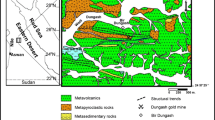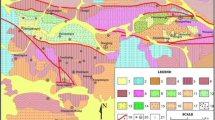Résumé
Une étude systématique des pouvoirs réflecteurs (PR) et des compositions chimiques des minéraux de la phase métallique dans des météorites pierreuses a été entreprise, au moyen de dosages à la microsonde électronique, et des mesures de PR sur une même plage. Les résultats concernant les principaux minéraux se groupent comme suit:
-
(a)
Météorites dont la phase silicatée renferme de l’olivine et du pyroxène plus ou moins riche en FeO (teneurs variables en fayalite et en bronzite, hypersthène).
-
(1)
Les ferronickels sont hétérogènes et fournissent dans une même météorite au moins deux phases, une de kamacite à 6 à 9% de Ni, une autre de taenite, souvent une troisième phase de taenite à plus de 30% de Ni. Les teneurs en Co sont liées à la richesse en Fe, avec une concentration sur les bords externes des taenites. Les PR sont croissants en fonction des teneurs en Ni.
-
(2)
Les troïlites sont homogènes, de composition chimique standard et ne montrent pas de variations des PR d’une météorite à l’autre.
-
(3)
Le Ti, Mn. Cr, Al sont localisés dans les oxydes métalliques, ilménite et chromite.
-
(i)
L’ilménite renferme le contenu en Ti-Mn; elle n’est pas magnésienne et appartient au type de PR maximal.
-
(ii)
La chromite, dont la richesse en Fe oxydé est en rapport direct avec les teneurs en FeO des silicates, se montre souvent sous deux formes: Une première génération de chromite essentiellement métallique, en gros grains spinelliformes, au PR élevé, et une seconde génération, en petits grains automorphes, aux allures semimétalliques, au PR peu élevé, renfermant de l’alumine et du magnésium. Dans le cas d’absence d’ilménite, c’est dans les chromites de cette seconde génération que sont renfermées les teneurs en Ti et Mn.
-
(i)
-
(4)
Le cuivre est entier sous forme de Cu natif.
-
(1)
-
(b)
Météorites à enstatite et à forstérite.
-
(1)
Le Fe de la météorite étant groupé en entier dans la phase métallique, le FeNi sera pauvre en Ni et homogène.
-
(2)
Le titane est fixé dans les troïlites, à des teneurs variant dans la même météorite, et pouvant aller jusqu’à 4%. Le PR de la troïlite se trouve diminué.
-
(3)
Le chrome figure sous forme de daubréelite: les rapports Fe/Cr variant légèrement, l’extrême sensibilité des PR finit par donner des courbes homologues accusant étroitement les teneurs respectives.
-
(4)
Les niningérites dont les variations de composition sont plus complexes (Mg, Al, Mn, Cr, Fe) fournissent toute une famille de courbes de PR homologues, mais aux paliers pouvant accuser des différences jusqu’à 6% PR.
-
(5)
Le phosphore ne pouvant figurer sous forme oxydée est concentré dans les schreibersites, aux teneurs en Ni variées; la présence de (Fe, Ni)2 est discutée.
-
(6)
Enfin l’oldhamite, renfermant des <1.5% de Mg, fournit une série de courbes optiques étroitement liées aux teneurs en Mg qui font baisser les PR.
-
(1)
Abstract
Using an electronic microprobe the authors make a systematic study of the reflecting power (PR) and chemical composition of minerals of the metallic phase in stone meteorites, and measure the reflecting power over a given range. The results obtained for the chief minerals can be grouped as follows:
-
(a)
Meteorites whose silicate phase contains olivine and pyroxene more or less rich in FeO (variable contents of fayalite, bronzite and hypersthene).
-
(1)
The ferronickels are heterogeneous and contribute at least two phases in the same meteorite, the first of which is kamacite with 6–9% Ni, and the second taenite; there is often a third taenite phase with more than 30% Ni. The Co contents are associated with richness in iron and are concentrated on the outer edges of the taenites. The reflecting power increases as a function of the amount of Ni present.
-
(2)
The troilites are homogeneous, with normal chemical composition, and do not exhibit any variation in reflecting power from one meteorite to another.
-
(3)
Ti, Mn, Cr and Al are localized in the metal oxides, ilmenite and chromite:
-
(i)
the ilmenite includes the Ti-Mn content; it is non-magnesian and belongs to the maximum reflecting power type;
-
(ii)
the chromite, in which the iron oxide content is in direct proportion to the amount of FeO in the silicates, often appears in two forms:
-
There
is an initial formation of essentially metal chromite with large spinel-like grains and high reflecting power, and a second formation which has small idiomorphic grains, a metalloid appearance, and a low reflecting power, and contains aluminium and magnesium;
-
When
there is no ilmenite present, it is the chromites from the second formation that contain Ti and Mn.
-
(4)
Copper is present entirely in the form of natural Cu.
-
(b)
Meteorites with enstatite and forsterite:
-
(1)
Since the iron in the meteorite is concentrated entirely in the metal phase, the Fe, Ni is poor in Ni and homogeneous;
-
(2)
Titanium is fixed in the troilites, the content varying within the same meteorite and reaching as high as 4%. The reflecting power of troilite is reduced.
-
(3)
Chromium is present in the form of daubreelite; since the Fe/Cr ratios vary slightly, the extreme sensitivity of the reflecting power results in homologous curves accurately marking the respective contents.
-
(4)
The niningerites, which show more complex variations in composition (Mg, Al, Mn, Cr and Fe), provide a complete family of homologous reflecting power curves, with plateaux showing differences of up to 6% in the reflecting power.
-
(5)
Since it cannot appear in the oxidized form, phosphorus is concentrated in the schreibersites with varying Ni content; the presence of (Fe, Ni)2 P is discussed.
-
(6)
Oldhamite containing less than 1.5% Mg provides a series of optical curves closely related to the Mg contents, which reduce the reflecting powers.
Access this chapter
Tax calculation will be finalised at checkout
Purchases are for personal use only
Preview
Unable to display preview. Download preview PDF.
Similar content being viewed by others
Bibliographie
B. Mason, Geochim. Cosmochim. Acta, 27 (1963) 1011.
R. Caye, R. Giraud, G. Sagiroglu, A. Sandrea, L’octahedrite de Kayakent, Turquie. Unpublished.
P. Ramdohr, Geochim. Cosmochim. Acta, 31 (1967) 1961.
E. A. Goldberg, A. Uchiyama, H. Brown, Geochim. Cosmochim. Acta, 2 (1951) 1.
S. J. B. Reed, Geochim. Cosmochim. Acta, 31 (1967) 1969.
Author information
Authors and Affiliations
Editor information
Editors and Affiliations
Rights and permissions
Copyright information
© 1969 D. Reidel Publishing Company, Dordrecht, Holland
About this paper
Cite this paper
Cayé, R., Giraud, R., Sandrea, A. (1969). Phase Métallique des Météorites Pierreuses. In: Millman, P.M. (eds) Meteorite Research. Astrophysics and Space Science Library, vol 12. Springer, Dordrecht. https://doi.org/10.1007/978-94-010-3411-1_54
Download citation
DOI: https://doi.org/10.1007/978-94-010-3411-1_54
Publisher Name: Springer, Dordrecht
Print ISBN: 978-94-010-3413-5
Online ISBN: 978-94-010-3411-1
eBook Packages: Springer Book Archive




